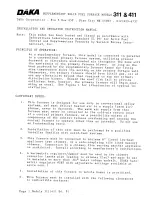
20
1 SQ IN .
PER
4
000
BTUH*
DUCTS
TO
O UTDOORS
1 SQ IN.
PER 4
000
BTUH*
C
IRCULA
TING
AIR DUCTS
VENT
THR OUGH
R OOF
D
B
A
C
E
1 SQ IN.
PER 4
000
BTUH*
DUCT
TO
OUTDOORS
CIRCULA TING AIR DUCT S
1 SQ IN.
PER 2
000
BTUH*
1 SQ IN.
PER 2
000
BTUH*
DUCT S
TO
OUTDOORS
12
″
MAX
12
″
MAX
12
″
MAX
12
″
MAX
12
″
MAX
OUTDOORS
1 SQ IN .
PER
4
000
BTUH*
F
G
CLEARANCE IN FRONT
OF COMB
USTION AIR
OPENINGS SHALL BE
AT LEAST 3 IN
.
(3
0
5mm)
(3
0
5mm)
(3
0
5mm)
(3
0
5mm)
(3
0
5mm)
(7
6
mm)
A03174
Fig. 18 -- Air for Combustion, Ventilation, and Dilution
for Outdoors
1. For
other than fan-assisted appliances,
such as a draft
hood-equipped water heater:
A04002
2. For
fan-assisted appliances
such as this furnace:
A04003
If:
I
other
=combined input of all
other than fan-assisted
appliances
in Btu/hr
I
fan
= combined input of all
fan-assisted appliances
in Btu/hr
ACH = air changes per hour (ACH shall not exceed 0.60.)
The following requirements apply to the
Standard
Method and to
the
Known Air Infiltration Rate
Method.
1. Adjoining rooms can be considered part of a space if:
a. There are no closeable doors between rooms.
b. Combining spaces on same floor level. Each opening
shall have free area of at least 1 in.
2
/1,000 Btuh
(2,000 mm
2
/kW) of the total input rating of all gas
appliances in the space, but not less than 100 in.
2
(0.06 m
2
). One opening shall commence within 12 in.
(305 mm) of the ceiling and the second opening shall
commence within 12 in. (305 mm) of the floor. The
minimum dimension of air openings shall be at least
3 in. (76 mm). (See Fig. 19.)
CIRCULATING AIR
DUCTS
6" MIN
(FRONT)
Ü
CIRCULATING AIR DUCTS
VENT THROUGH ROOF
1 SQ IN.
PER 1000
BTUH* IN DOOR
OR
WALL
12" MAX
1 SQ IN.
PER 1000
BTUH* IN DOOR
OR
WALL
12" MA X
UNCONFINED
SPACE
INTERIOR
HEATED
SPACE
CLEARANCE IN FRONT OF COMBUSTION AIR
OPENINGS SHALL
BE A
T LEAST 3 IN.
(305mm)
(152mm)
(305mm)
A03175
Fig. 19 -- Air for Combustion, Ventilation, and Dilution
from Indoors
c. Combining space on different floor levels. The
volumes of spaces on different floor levels shall be
considered as communicating spaces if connected by
one or more permanent openings in doors or floors
having free area of at least 2 in.
2
/1,000 Btuh
(4,400 mm
2
/kW) of total input rating of all
gas appliances.
2. An attic or crawlspace may be considered a space that
freely communicates with the outdoors provided there are
adequate permanent ventilation openings directly to
outdoors having free area of at least 1-in.
2
/4,000 Btuh
(645.1 mm
2
/1.17 KWh) of total input rating for all gas
appliances in the space.
3. In spaces that use the
Indoor Combustion Air
Method,
infiltration should be adequate to provide air for
combustion, permanent ventilation and dilution of flue
gases. However, in buildings with unusually tight
construction, additional air MUST be provided using the
methods described in the
Outdoor Combustion Air
Method section.
Unusually
tight
construction
is
defined
as
Construction with:
a. Walls and ceilings exposed to the outdoors have a
continuous, sealed vapor barrier. Openings are
gasketed or sealed and
b. Doors and openable windows are weatherstripped and
c. Other openings are caulked or sealed. These include
joints around window and door frames, between sole
plates and floors, between wall-ceiling joints, between
wall panels, at penetrations for plumbing, electrical
and gas lines, etc.
















































